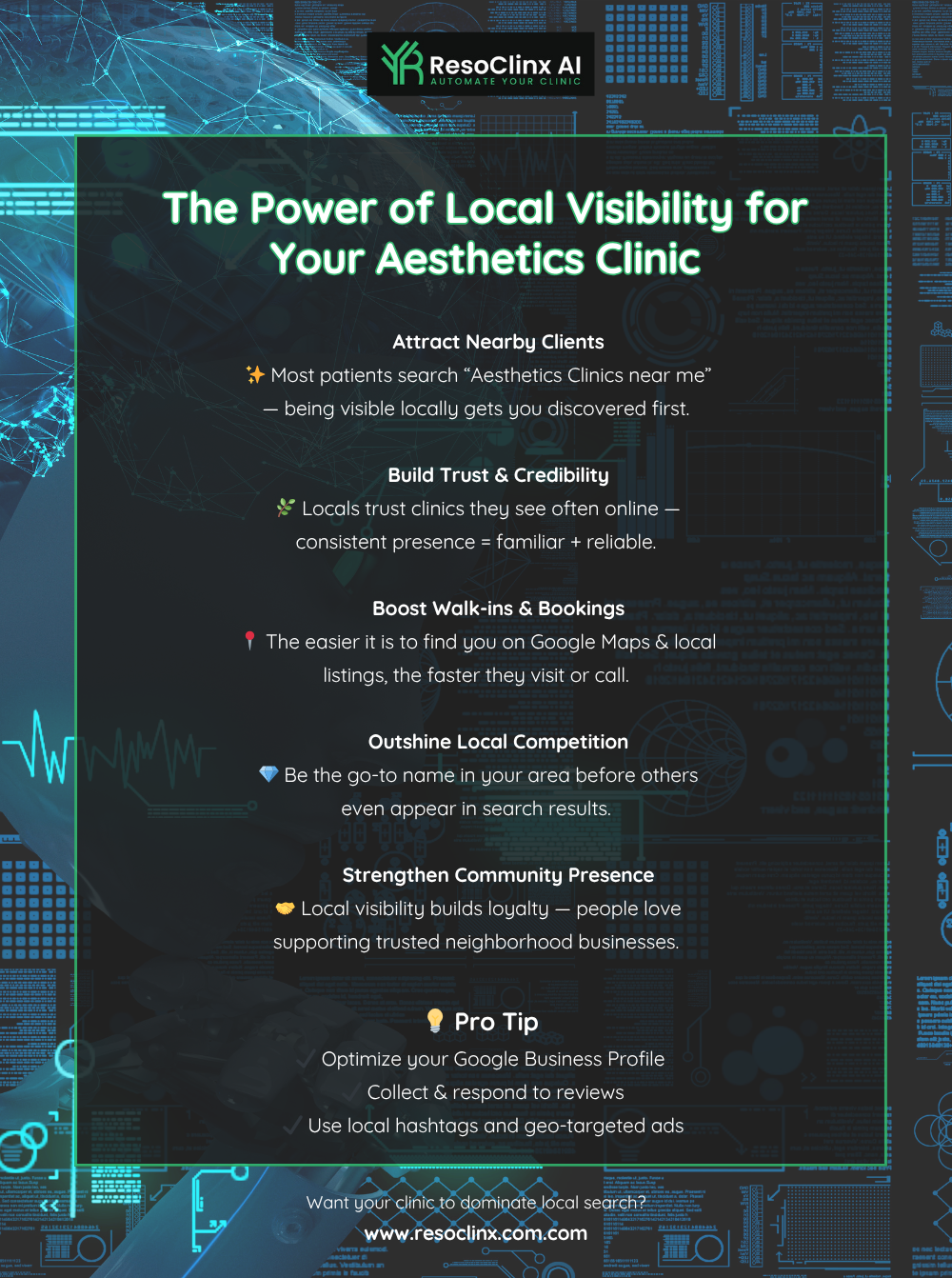Want to attract more clients to your aesthetic clinic? Most people discover local services online — and that’s where Local SEO (Search Engine Optimisation) comes in. Local SEO helps ensure your clinic appears when people nearby search for the treatments you offer.
In this guide, we’ll share clear, practical tips to improve your clinic’s online visibility so that new patients can easily find and trust you. Think of it as positioning your clinic as the go-to destination for aesthetic treatments in your area.
Key Takeaways
- Keep your Google Business Profile complete and regularly updated — it’s often the first thing local clients see.
- Use local keywords on your website, such as “lip fillers in [your town]”, to attract nearby searches.
- Encourage satisfied patients to leave Google reviews. Positive feedback builds trust and boosts visibility.
- Ensure your website is mobile-friendly and fast. A slow or clunky site turns people away.
- Gain quality backlinks from reputable sites to show Google your clinic is credible and trustworthy.
Optimise Your Google Business Profile For Local Visibility

Your Google Business Profile (GBP) is like the digital front door to your aesthetic clinic. It’s often the first impression potential patients get, so keeping it accurate, inviting, and up to date is essential.
This free Google tool is one of the most effective ways to attract local clients searching for aesthetic treatments. A fully completed and regularly maintained profile greatly improves your chances of appearing in local search results and on Google Maps.
Establish Your Clinic’s Digital Front Door
Your Google Business Profile is more than a basic listing — it’s your clinic’s online identity. Patients rely on it to find your name, address, phone number, opening hours, and website quickly.
When someone searches for “aesthetic clinic near me” or “Botox in [your town]”, an optimised profile helps ensure you appear in their results. Accurate and consistent information is the foundation of successful local SEO for clinics.
Maintain Accurate And Consistent Information
Accuracy is essential. Inconsistent details across websites can confuse both Google and potential patients — and may harm your clinic’s ranking. Keep your NAP details (name, address, phone number) identical everywhere, including your website, social media, and online directories.
Regularly update your opening hours, especially during holidays, and choose the most accurate category such as “Aesthetic Clinic” or “Medical Spa.” These small but vital details help Google show your profile to the right local audience.
Leverage High-Quality Visuals To Attract Clients
People respond strongly to visuals — especially in aesthetics. High-quality photos and short videos can make a huge difference in attracting new patients. Show your clinic’s interior, treatment rooms, friendly team, and (with patient consent) before-and-after results.
According to Google, profiles with photos receive more requests for directions and website visits. Keep your visuals current by adding new images that highlight treatments, updated décor, or seasonal promotions. A clean, modern look helps convey professionalism and trust.
Craft Engaging Website Content With Local Keywords

To reach people searching for aesthetic treatments in your area, you need to use the same language they do. That means including local keywords — phrases that combine your treatments with your location.
For example, “Botox in Birmingham” or “laser hair removal near Manchester.” These help your clinic appear in local search results when potential patients are ready to book.
Identify High-Intent Local Search Terms
Start by brainstorming how people in your community might search. Combine your main treatments with your town, city, or neighbourhood. For example, clinics in Leeds might target phrases like “dermal fillers Headingley” or “skin peels near Roundhay.”
Here’s a simple way to think about it:
- Service + Location: “Facial treatments Leeds”
- Treatment + Area: “Anti-wrinkle injections Harrogate”
- Problem + Location: “Acne scar treatment York”
Tools can help you find these, but often just thinking like a potential client is a good start. What would you search for?
Develop Location-Specific Service Pages
If your clinic serves several towns or has multiple branches, create dedicated location pages. For example, a page about your Sheffield clinic could mention local landmarks or neighbourhoods and include location-specific keywords. This signals to Google that you’re a genuine local business serving that community.
It’s about making it easy for someone searching for “aesthetics clinic near me” to find you and feel like you understand their local needs.
Integrate Keywords Naturally Into Your Content
Once you’ve identified your local keywords, integrate them naturally into your content — never overuse them. Include them in page titles, headings, meta descriptions, and throughout your service and blog pages where relevant.
Focus on creating genuinely helpful, informative content that signals clearly to both readers and search engines what services you provide and where you’re located.
For instance, if you’re writing a blog post about the benefits of a particular treatment, you could mention how it’s popular with clients in your specific town or region. It should feel natural, like you’re just talking about your services and your local area.
Cultivate A Stellar Online Reputation Through Reviews

Online reviews are the digital word-of-mouth for your aesthetic clinic — and one of the strongest tools for attracting new patients.
Think about it: when you’re looking for a service, don’t you check what other people have said? Potential clients do the same thing. A strong collection of positive reviews builds trust and shows that your clinic is a reliable place for treatments.
Google considers reviews a key ranking factor. They signal that your clinic is active and trusted by patients, which helps you rank higher in local searches. It’s not only about collecting five-star ratings — it’s about increasing your visibility and credibility.
Encourage Satisfied Patients To Share Their Experiences
Encouraging patients to leave reviews takes a thoughtful approach. Most happy patients are willing to share feedback — they just need a reminder. Ask shortly after their treatment, when they’re pleased with their results.
A short, polite request works well, especially if you include a direct link or QR code to your review page. The easier the process, the more likely they are to leave feedback.
- Ask at the right moment: When a patient expresses satisfaction, that’s your cue.
- Make it simple: Provide a direct link or QR code.
- Explain why it helps: Briefly mention how reviews help others choose the right clinic.
Respond Professionally To All Feedback
Every review — positive or negative — is an opportunity to demonstrate professionalism. Thank patients for positive feedback, and for negative comments, respond calmly and courteously. Acknowledge their experience, apologise if appropriate, and invite them to continue the conversation privately. This shows prospective clients that your clinic values feedback and patient care.
This shows potential patients that you care about client satisfaction and are willing to sort out problems. It’s not about winning an argument; it’s about showing you’re a responsible business owner.
Responding to feedback, both positive and negative, demonstrates that your clinic is actively listening and values patient input. This engagement can significantly influence a potential client’s decision-making process.
Showcase Positive Testimonials To Build Trust
Use your positive reviews strategically by featuring testimonials on your website — such as your homepage, service pages, or a dedicated testimonials section. Genuine patient feedback builds trust far more effectively than marketing copy alone.
If possible and with permission, include a patient’s first name or initials and perhaps even a photo. This adds a personal touch and makes the testimonial feel even more genuine, building a strong sense of trust with anyone considering your services.
Here’s how to make the most of testimonials:
- Website Integration: Feature them prominently on your site.
- Social Media Sharing: Share snippets of positive reviews on your social channels.
- Service Page Spotlights: Link relevant testimonials to specific treatments you offer.
Enhance Your Website’s User Experience For Better Rankings
Your website functions as your digital reception area. If it’s slow, cluttered, or confusing, potential patients will simply leave and choose another clinic.
Making your website easy and pleasant to use is not just good practice; it directly helps search engines like Google see your site as a helpful resource, which can improve where you show up in search results.
Ensure Seamless Mobile Responsiveness
Most people browse the internet on their phones these days. If your website looks messy or is difficult to use on a smaller screen, you’re missing out on a huge number of potential patients. A website that adapts well to any screen size, from a large desktop monitor to a small smartphone, is absolutely key. This means text should be readable without zooming, buttons should be easy to tap, and the whole layout should just make sense, no matter the device.
Optimise Site Speed For Faster Loading
Nobody likes waiting for a webpage to load. If your site takes too long, visitors will click away before they even see what you have to offer. Slow loading times can be caused by large images, unoptimised code, or poor hosting. Improving your site speed means potential clients can find the information they need quickly, leading to a better experience and a higher chance they’ll book an appointment.
Here are a few ways to speed things up:
- Compress images: Make sure your photos are sized correctly for the web.
- Minify code: Remove unnecessary characters from your website’s code.
- Use a good hosting provider: Choose a reliable company that offers fast servers.
- Limit plugins: Too many add-ons can slow your site down.
Implement Clear Navigation And Calls To Action
Once visitors are on your site, they need to be able to find what they’re looking for easily. A clear, logical menu helps them explore your services, learn about your team, and find contact information. Equally important are clear calls to action (CTAs). These are prompts that tell visitors what to do next, like “Book a Consultation” or “Learn More About Treatments.” Well-placed and obvious CTAs guide users towards taking the next step in their journey with your clinic.
Making your website user-friendly is about more than just looks; it’s about creating a helpful and efficient experience for everyone who visits. When people can easily find what they need and understand how to proceed, they’re more likely to become patients.
Build Authority With Strategic Link Building
Earn Quality Backlinks From Reputable Sources
Earning backlinks from reputable websites significantly boosts your clinic’s online authority. Think of it like getting a recommendation from a respected friend. These links, often called backlinks, tell search engines that your clinic is a reliable source of information and services. The more quality links you have pointing to your site, the more authority you build.
How do you get these links? One way is by creating really useful content that other sites want to reference. This could be in-depth guides on treatments, research on new aesthetic techniques, or even local health and beauty news. When your content is informative and unique, other clinics, local publications, or health blogs might naturally link to it.
Another approach is to reach out directly. Identify websites that are relevant to your field – perhaps local lifestyle magazines, health directories, or even complementary businesses like high-end spas or dermatologists. See if they have a section for local businesses or resources and suggest your clinic as a valuable addition. Always aim for quality over quantity; a few links from highly respected sites are far better than many from low-quality ones.
Engage In Guest Blogging On Industry Websites
Guest blogging is a fantastic way to get your clinic’s name out there and build authority. It involves writing articles for other websites in the aesthetics or local health and wellness space. When you write for a reputable site, you’re not just sharing your knowledge; you’re also getting a link back to your own website, usually in your author bio.
This strategy does a couple of things. Firstly, it exposes your clinic to a new audience that might not have found you otherwise. Secondly, it positions you as an expert in your field. When people see your name associated with trusted industry publications, it builds confidence in your services.
When choosing where to guest post, look for sites that your ideal clients might read. Think about blogs that discuss skincare, anti-ageing, or local beauty trends. Make sure the content you offer is genuinely helpful and informative, not just a sales pitch. A well-written article can attract new patients and establish your clinic as a go-to resource.
Strengthen Your Online Presence Through Social Media
While social media might seem separate from link building, it plays a vital role in strengthening your overall online presence and can indirectly lead to more backlinks. By being active and engaging on platforms like Instagram, Facebook, or even LinkedIn, you increase your clinic’s visibility.
When you share your blog posts, treatment information, or patient success stories on social media, you’re making that content discoverable to a wider audience. People who find your content interesting might then decide to link to it from their own blogs or websites. It’s like casting a wider net for potential links.
Furthermore, active social media profiles can be a source of direct traffic to your website. When potential clients see your engaging posts, they’re more likely to click through to learn more about your services. This increased website traffic can also be a positive signal to search engines. Don’t forget to include links to your website in your social media profiles too – it’s a simple but effective way to guide interested users directly to you.
Measure And Refine Your Local SEO Strategy

So, you’ve put in the work to optimise your Google Business Profile, peppered your website with local keywords, and encouraged patient reviews. That’s fantastic! But how do you know if it’s all actually working?
This is where the measuring and refining part comes in. It’s not a ‘set it and forget it’ kind of deal; it’s an ongoing process to make sure your efforts are paying off.
Tracking your clinic’s local SEO performance helps you understand which strategies attract more clients.
Track Website Traffic and Keyword Performance
First off, you need to see who’s actually visiting your site and what they’re looking for. Tools like Google Analytics are your best friend here. You can see how many people are landing on your website, where they’re coming from (did they find you through a Google search, or a social media link?), and which pages they’re spending the most time on.
It’s also super important to keep an eye on your keyword performance. Are the local terms you’re targeting actually bringing people in? You can use Google Search Console to see which search queries are leading users to your site. This helps you understand if your keyword strategy is hitting the mark or if you need to adjust your approach.
Here’s a quick look at what to monitor:
- Website Visitors: How many people are coming to your site?
- Traffic Sources: Where are they coming from (organic search, direct, social, etc.)?
- Top Performing Pages: Which pages are getting the most views?
- Keyword Rankings: Are you showing up for the local terms you want to rank for?
- Bounce Rate: Are people leaving your site immediately, or are they exploring?
Analyse User Behaviour and Conversion Rates
Knowing that people are visiting your site is one thing, but understanding what they do once they get there is another. Are they clicking on your ‘Book Appointment’ button? Are they filling out your contact form?
These actions are called conversions, and they’re the ultimate goal, right? You want people to take that next step towards becoming a patient. By looking at your conversion rates, you can see how effective your website is at turning visitors into leads.
If your conversion rates are low, it might mean your calls to action aren’t clear enough, or perhaps the user journey on your site isn’t as smooth as it could be.
Analysing user behaviour helps you pinpoint exactly where potential patients might be dropping off in the process. It’s like having a map that shows you the roadblocks on the path to booking an appointment, allowing you to clear them away.
Adapt Your Approach Based On Data Insights
This is where the ‘refine’ part really kicks in. All the data you’ve collected isn’t just for looking at; it’s for acting on. If you notice that a particular service page isn’t getting much traffic, maybe you need to add more relevant local keywords or improve its meta description. If your Google Business Profile isn’t getting many calls, perhaps you need to add more compelling photos or update your services list.
Regularly reviewing your performance metrics allows you to make informed decisions and continuously improve your local SEO strategy. It’s about being agile and willing to tweak things based on what the data is telling you. This iterative process is what will keep your clinic visible and attract new patients consistently.
Your Local SEO Success Story
Local SEO may seem complex, but with consistent effort, your aesthetic clinic can become highly visible to nearby patients searching online.
It might seem like a lot at first, but remember, each step you take makes your clinic more visible to the people who are actively looking for your services. Think of it as opening your clinic’s doors wider to new clients. By putting these local SEO tips into practice, you’re not just improving your search rankings; you’re building connections within your community and paving the way for a busier, more successful practice. Let’s get your clinic seen!
Frequently Asked Questions
What is Local SEO and why is it important for my aesthetic clinic?
Local SEO is like making sure your clinic shows up when people nearby search for treatments like ‘Botox’ or ‘skin tightening’. It helps people in your area find you easily online, especially on Google. For aesthetic clinics, this is super important because most patients want to go to a clinic that’s close to them. Good local SEO means more local people see your clinic when they’re looking for services, which can lead to more appointments.
How can I make my Google Business Profile stand out?
Your Google Business Profile acts as your clinic’s online shop window. Ensure your details — name, address, and phone number — are accurate and consistent across all online platforms.
What kind of words should I use on my website to attract local patients?
Use local keywords — phrases that combine the treatments you offer with your clinic’s location.For example, instead of just 'lip fillers', use 'lip fillers in Birmingham' or 'best aesthetic clinic near me'. This tells Google exactly where you are and who you want to attract. Sprinkle these words naturally into your website's text, especially on pages about your services.
How important are online reviews for my clinic's reputation?
Online reviews are really, really important! They're like word-of-mouth recommendations, but online. When people are looking for a clinic, they check reviews to see what others think. Getting lots of good reviews builds trust and shows potential patients that you're a great choice. It's also a big factor in how high you appear in local search results.
Should my clinic's website work well on phones?
Absolutely! Most people search for things on their phones these days. If your website is hard to use on a mobile device, people will just leave and find someone else. Make sure your website loads quickly and looks good on phones and tablets. This is called 'mobile responsiveness' and it's a must-have for good local SEO.
How do I know if my local SEO efforts are actually working?
You need to keep an eye on things! Use tools like Google Analytics to see how many people are visiting your website, where they're coming from, and what pages they look at. You can also track which keywords are bringing people to your site. By looking at this information, you can see what's working well and what you need to change to get even better results.






